To put his Battle Born lithium batteries to the cold weather test, Scott Hallenberg took his Hallmark Milner to 8,500-feet with temperatures dropping to 12ºF (-11.1ºC). Without solar or a generator, he was off-road, off-grid, and perhaps out of his mind.
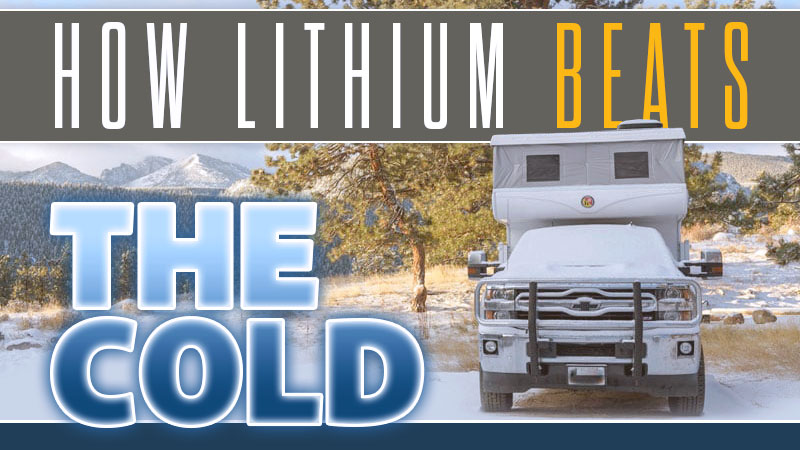
Every once in awhile receive a Bought A Camper report showcasing an extraordinary camper build, truck and camper combination, or truck camping lifestyle. I know when these opportunities arrive because Angela says, “Now that’s a story!”
In October of last year, Scott Hallenberg submitted a Bought A Camper report that described a very specific set of requirements for his professional outdoor photography. First and foremost, he needed to be able to camp off-road, off-grid, at altitude, in particularly cold weather.
These requirements led Scott to select a Hallmark Milner pop-up camper with a Truma Combi eco, TruckFridge 12-volt compressor refrigerator, and Battle Born lithium batteries. He also opted against solar panels and a portable generator.
All of this both intrigued and puzzled us. Winter camping and lithium batteries? Off-grid and no solar or generator? And exactly how will a Truma Combi eco perform in a Hallmark?
To up the ante, Scott took his Hallmark rig on an extreme cold weather test that dipped to 12ºF (-11.1ºC), at 8,500-feet with no hookups.
“Now that’s a story!”
Yes, it is Angela. Yes, it is.
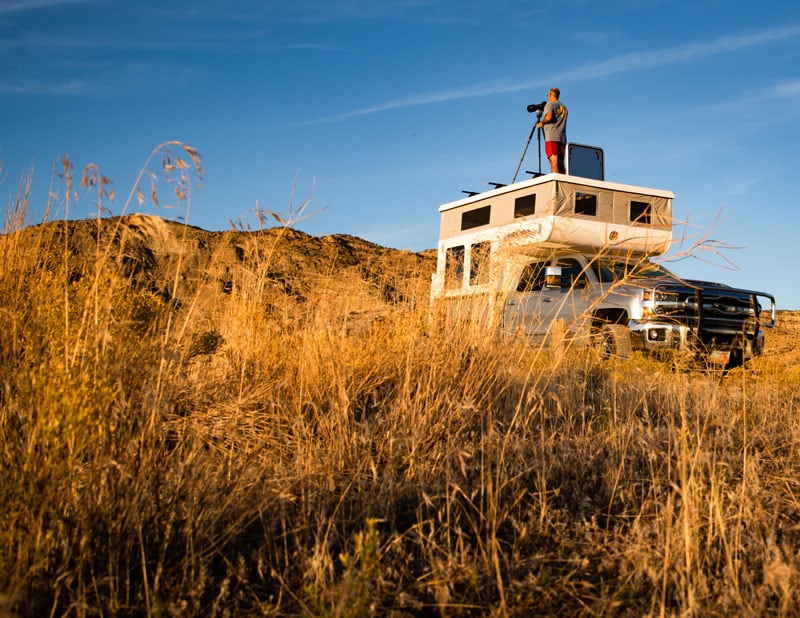
Above: As a professional photographer, Scott wanted the roof of his camper to be strong enough to stand on
Before we talk about your Hallmark, tell us your truck camping lifestyle.
My wife, Susan, dog, Willy, and I got into truck camping in a round about way. We started with a vintage Airstream and a small tow vehicle. We liked the freedom it brought us, especially as we learned more about dispersed camping. We kept finding beautiful places with views of the Tetons, Colorado Rockies, Eastern Sierras as well as in our nearby Uinta mountain backyard.
We keep a horse trailer for possible wildfire evacuations, which led to us selling the undersized SUV to buy a larger tow vehicle, a 2017 Chevy 3500HD. The truck became our gateway drug. We even upgraded to a larger and more modern Airstream.
We lived in the larger Airstream full-time for six-months as we transitioned to a smaller home. We loved the simplicity of the lifestyle and I enjoyed tinkering with the systems to give us more off-grid range; lithium batteries and lifting the Airstream.
We got even more into dispersed camping with this capable vehicle. That led us to our next step. A truck camper would be perfect for when the horse trailer wasn’t in use.
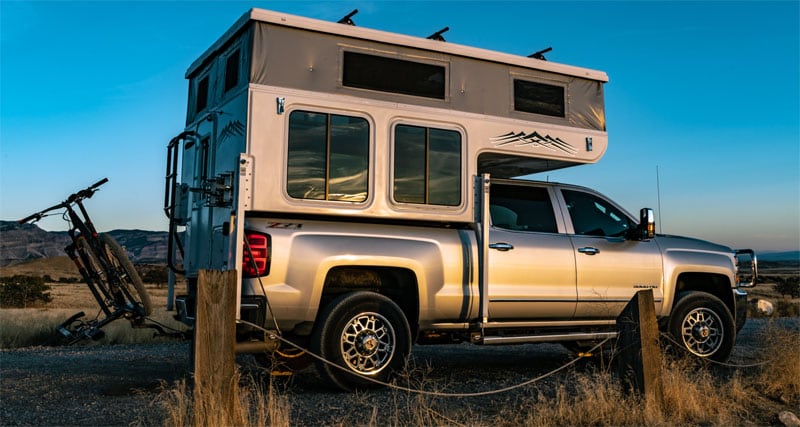
As a full-time photographer, a truck camper was something I could take on adventures when my wife couldn’t get away. Dragging an Airstream just wasn’t that practical for the off-road exploring we wanted to do. A truck camper would allow us to go anywhere our truck could go with creature comforts like heating, cooking, and running water.
We also liked the fact that we could take our mountain bikes, be a little more spontaneous, and enjoy more remote camping opportunities.
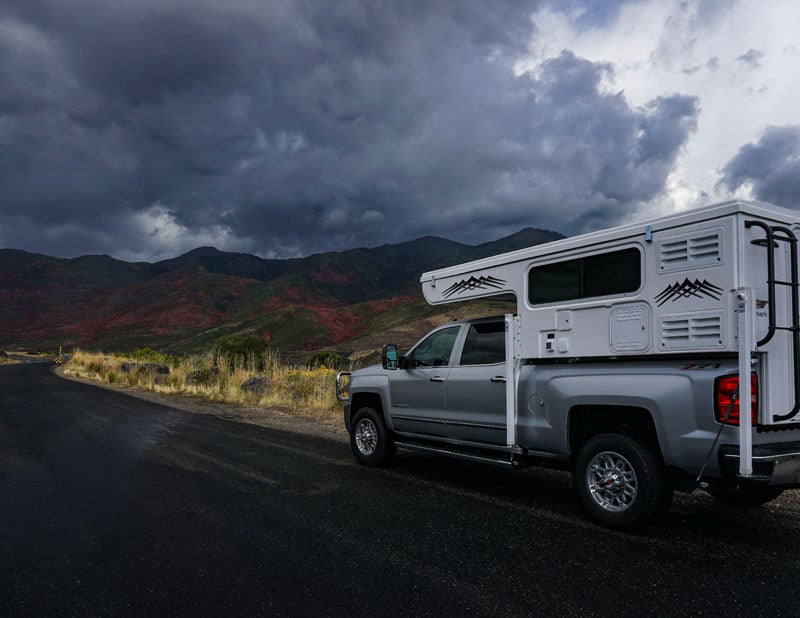
Above: 2017 Chevy Silverado 3500 and 2019 Hallmark Milner in Park City, Utah
Why did you decide to get a pop-up instead of a hard side truck camper?
I thought that if we could stay warm in a pop-up, having a lower profile would be great for forest service roads, low hanging branches, fuel economy on the interstate, and the crosswinds that are so typical in the west.
The only real downside of a pop-up is that some places, like Glacier or Lake Louise, restrict soft sides. They are treated like tents and restricted from camping areas where there is known Grizzly bear activity. I believe this is an unnecessary requirement since the soft side of a pop-up truck camper starts at 8-feet off the ground.
In practice, I’ve never felt unsafe because of the soft sides. In fact, because of all the extra windows, I get a full 360-degree view and might see approaching weather, wildfires, or anything that approaches our location.
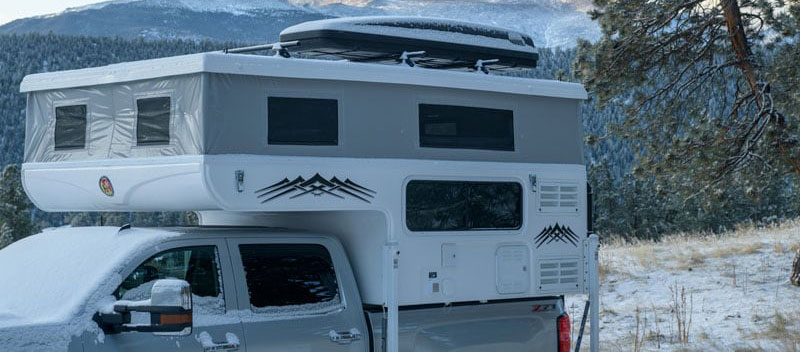
Above: The soft-sided thermal pack that Hallmark installs in their pop-ups
More importantly, the added light and views make a pop-up camper very enjoyable. I also believe, “a Grizzly gets what a Grizzly wants” and would likely come through a hard side door or window if they were motivated. Keeping a clean campsite is imperative regardless of the mode of camping.
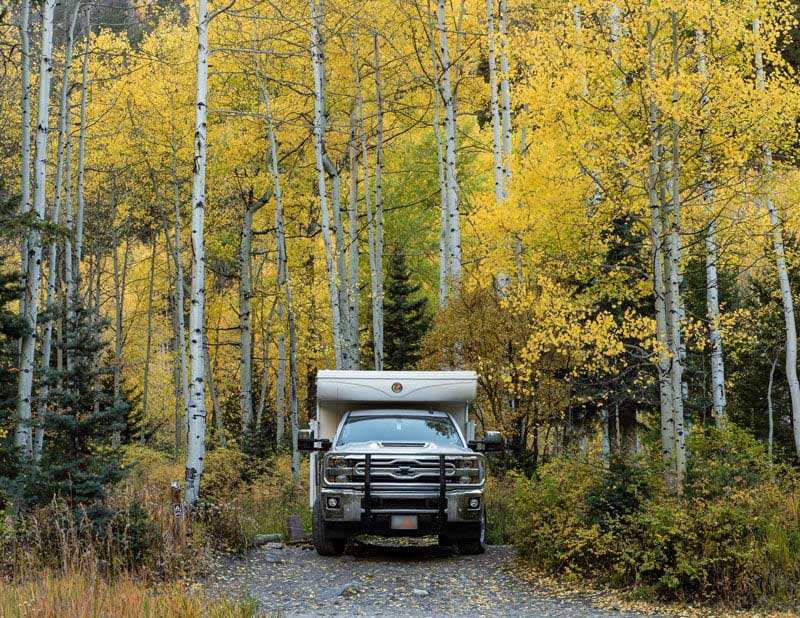
Above: Ouray, Colorado
Why did you choose Hallmark?
I checked out all of the pop-up camper manufacturers in great detail. When I discovered Hallmark, I really appreciated their innovative composite fiberglass construction. They are built similar to a sailboat, of which I have some experience.
Fiberglass composite is strong, has some give, offers superior insulating properties to aluminum, and can last decades and still look good. I also like Hallmark’s roof lift mechanism which allows for high snow loads or people engaging in night sky photography.
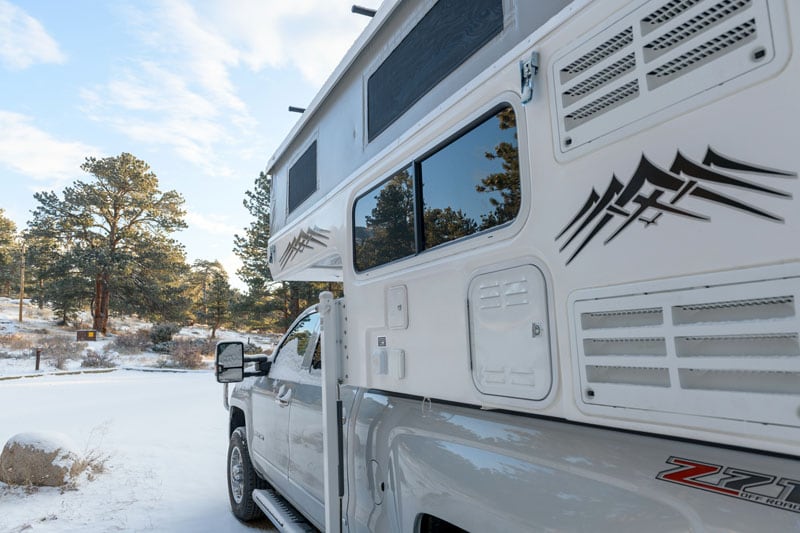
Given these characteristics, I thought they might be open to trying a few things like installing a lithium battery system, Truma Combi heater and hot water system, and even a marine-styled skylight for night sky viewing. The skylight (pictured below) would also give me access to the roof without climbing a ladder.
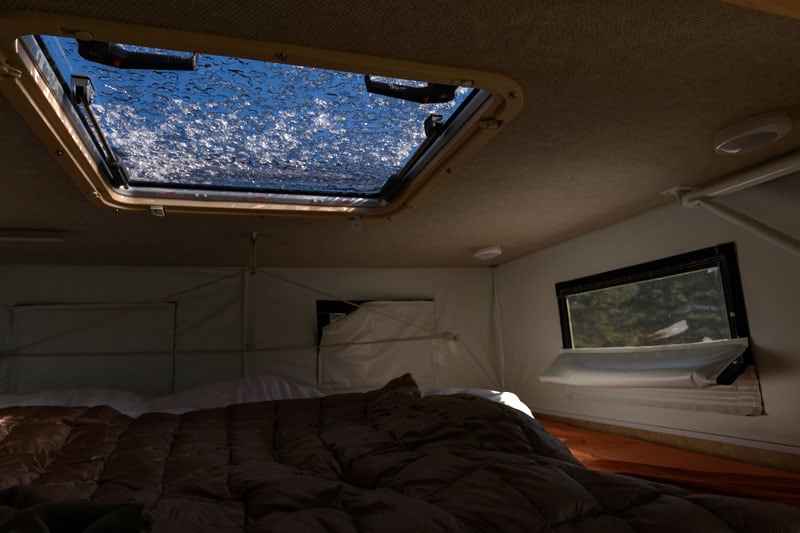
After meeting with Bill and Matt Ward for a Hallmark factory tour and feature walkthrough, I was convinced they would deliver an awesome product. It helped that they are located within a half-day’s drive. I like supporting small companies who demonstrate pride in workmanship whenever I can.
I selected the Hallmark Milner, which kept things rather basic. To save a little money, I decided to forgo an indoor shower, refrigerator, and toilet. After all, this was more of a man cave build than a couple’s retreat. I did request a Lewmar skylight (pictured above), Truma Combi eco plus, and a 100 ampere-hour lithium battery.
The Milner fits into a 6.5-foot truck bed without overhang. I wasn’t too concerned about payload given the 3500HD, but I liked that it would be on the lighter side making it even easier to traverse rutted dirt roads. It also makes for easy access to the truck’s hitch without needing an extension. I could use my normal bike rack or tow if I wanted. Otherwise, a step insert fits nicely.
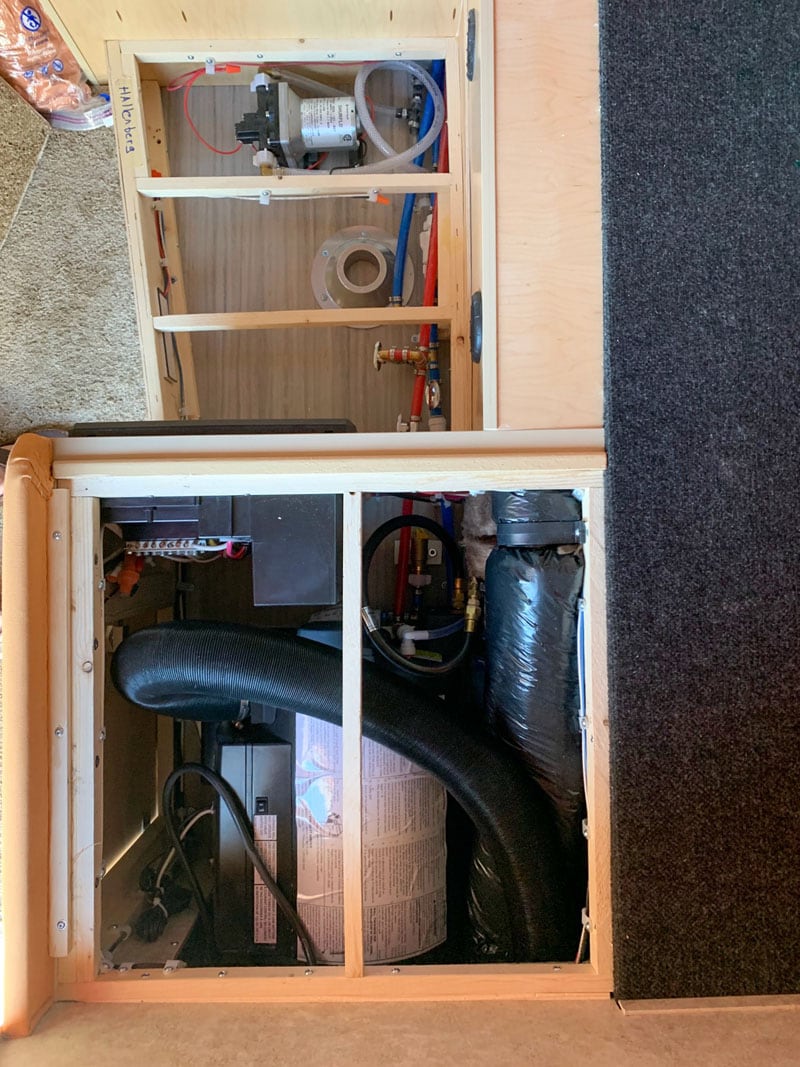
Above: The Truma Eco Combi Plus in the wild. This overhead view shows the Truma mounted in the rear of the camper on the passenger’s side. It’s against the rear bulkhead so that it can collect and exhaust the combustion air.
Why did you request the Truma Combi eco plus for your Hallmark?
My research led me to Truma as many truck camper users had reported issues with the traditional RV heaters. First, the voltage drop in the batteries would not start the heaters. And second, the heaters were failing due to altitude or mechanical issues.
Voltage drop naturally occurs in AGM and lead acid batteries due to their inherent chemistry and is exacerbated in cold temperatures when you need the heat the most.
As I explored alternatives, I found that my neighbor had a van with a Truma system. He said it worked great in the same areas we like to camp. We live near Park City, Utah at 6,500 feet and frequently camp above 9,500 feet. From his experience, the Truma passed the altitude and cold weather tests.
I liked the idea of combining the furnace and water heater functions because it takes up less space. I also liked how it used about a third of the amp hours and was more efficient with propane usage compared to traditional RV appliances.
I liked that the Truma Combi has ducted heating for more even warmth. It runs on either propane or 110-volt shore power which is particularly nice for staging. It can run in furnace only mode for winter camping or hot water only mode during the summer. When the furnace isn’t running, there’s a quiet ten-speed recirculating fan to move air and help control condensation.
“I liked the idea of combining the furnace and water heater functions because it takes up less space.”
Were there challenges to installing the Truma in the Milner?
Truma does not sell direct to consumers. For a manufacturer to install a Truma system, they need to have their camper design approved by Truma engineers.
Matt Ward at Hallmark had been looking at them, but Hallmark hadn’t installed one yet. Truma Combis are popular in the European market and Winnebago had recently begun using them in North America. So, there is an established community of users.
Since the Truma is different than traditional systems, Hallmark had to figure out how to accommodate the engineering requirements into an existing floor plan. That process was successful, but required considerable engagement between Truma and Hallmark.
How does it perform?
As a heater, it’s much quieter than traditional RV heaters. The heat works very well.
The Combi does work in furnace only mode which is useful for some winter camping scenarios. It also works in hot water mode only which is useful in spring and summer conditions, and it allows for a 10-speed recirculating fan to be used.
The water heater portion of the Truma also works well, but I don’t use a lot of water when winter camping. I only use it for cooking, cleaning, and basic hygiene.
The Milner does not have a permanent grey tank. Hallmark designs call for an external portable grey tank, but I re-routed the under sink drain line to an internal five-gallon tank which stays warm and is better for winter conditions.
I do have a fresh water tank and pump in an extra insulated and heated compartment. The ducting extends along the water lines and under the sink.
When using the outside shower, the Truma works great. The 2.64-gallons (10-liters) of hot water mixes with the cold and allows for a pre-rinse, soap, and rinse operation Navy shower for two people. One luxury shower is possible. It takes a little over twenty-minutes to heat another tank of water.
To winterize the Truma Combi, you simply close a bypass valve so that cold water does not flow to the Combi and then open the drain valve which all releases the water inside the Combi. There is no need to blow air or run RV antifreeze, but it is imperative the Combi is winterized if the heater is turned off and the camper is below freezing.
Have you been able to gauge how efficient the Truma is with propane?
Not in an objective way, but it is efficient for sure. The Hallmark Milner has a horizontal 20-pound tank and I carry extra 10-pound tanks as back-up and for accessory use. I can get several weeks using this set up continuously without worrying. I do carry a fish scale to measure the tanks if I want to know how much propane is left.
How about the 12-volt draw?
When heating, the Truma is very efficient with the amps. When the fan is blowing, it’s draws about 2-amps. During a cold night where it’s running a lot, I may use between 15 and 25 amp-hours. This includes lights and phone charging as well. Getting three to four nights without recharging the batteries on a 100aH system is easy.
Would you make any changes to the way the Truma system was implemented?
There are a couple of things I might do differently. First, I would route one of the ducts through the under bed storage area. For now, I raise the bed before going to sleep and allow that space to fill with warm and dry air. Then close it up for the night.
Second, it would be good to locate the Truma closer to the sink and external shower to shorten the hot water run.
If you had to design the build over again, would you still opt for the Truma?
Yes, I do think the Truma Combi is an excellent solution for tight quarters. I thought it might be a bit overkill with its 14,300 BTU rating, but it’s been great.
Propane is great for camping at altitude as it doesn’t experience carbon build up like diesel and petrol fuel sourced heaters. And the Truma works efficiently off 110-volts as well. This is convenient when shore power is available, but also has great promise in setups with large battery banks and an inverter. It’s nice to have redundancy.
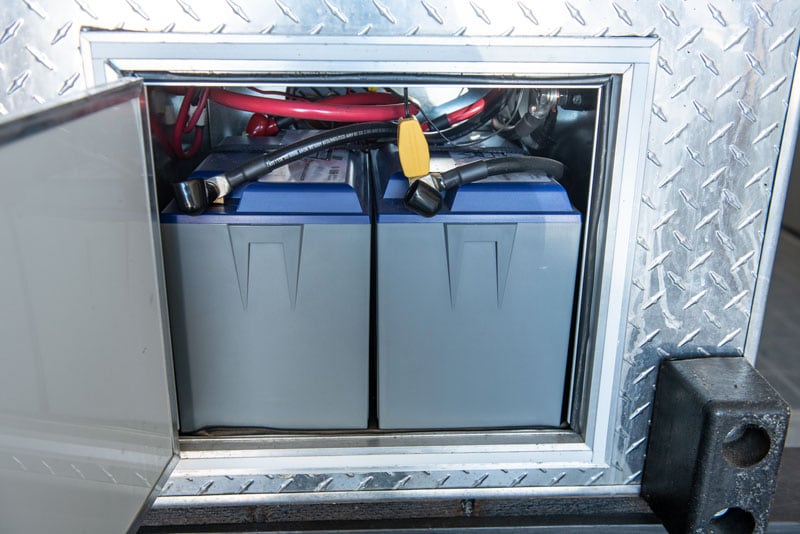
Above: Later after the 12V Truck Fridge was installed, a second Lithium battery was added and the Sterling Battery to Battery charger was relocated into an interior cabinet.
What are the benefits of lithium batteries that made lithium worth the cost?
I decided to invest in lithium batteries for several reasons. First and foremost, I was convinced they would last many times longer and perform better during their lifetime.
In turn, 12-volt appliances would also perform better. Lithium batteries maintain a flat and stable voltage throughout the cycle, where AGMs and lead acid batteries experience significant voltage drops under load.
Lithium batteries also don’t degrade when receiving partial charges or partial discharges. While camping, clouds and shady trees can result in short or intermittent battery charging. These situations can damage AGM and lead acid batteries, but don’t phase lithium batteries.
Because lithium batteries are lighter and you get nearly 100-percent depth of discharge, one 100aH battery can equal two AGM batteries, but with half the space the 25-percent of the weight. In a truck camper all of these characteristics matter. Plus, when not in use and if isolated, lithiums maintain their charge without a trickle charger.
What brand and model of lithium batteries did you choose?
I selected Battle Born lithium batteries. They have a solid battery management system to protect the battery and offer a terrific warranty. They’re also located in Reno. As mentioned previously, I like to support regional companies.
Battle Born has tested their batteries with many systems and puts that information on their website. This is how I decided to include a Sterling battery-to-battery charger (BB1230). It effectively supplies up to 30-amps to the lithium batteries while driving. A depleted 100-amp hour battery can be recharged in a just few hours of driving.
Battle Born’s information also led to the Victron BMV 712 with Bluetooth. The Victron is set up so all the current passes through a shunt and has a temperature sensor connected to the batteries. Either on the unit display or through the Victron Bluetooth app, I can see the status of the system, the overall usage, and know how much is remaining. With that information, I can learn about the system and make adjustments.
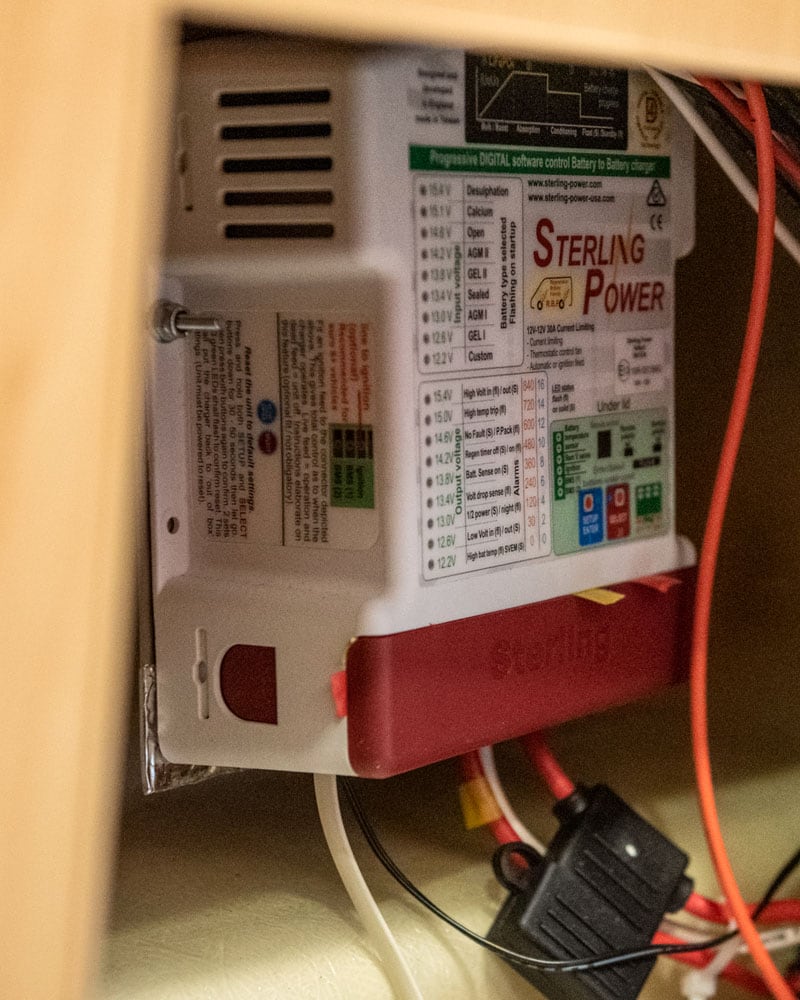
Above: The new location of the Sterling Battery to Battery Charger. It charges two Battle Born Lithium Batteries while driving. It has worked so well camping for one or two nights in a location that solar hasn’t been needed.
Does the Sterling battery-to-battery charger only charge while you drive, or can it pull from your truck while camping?
When parked, the truck’s batteries are isolated from the camper’s batteries. When I’m on shore power, the camper’s batteries are charged via the progressive dynamic converter.
If I were building the system again, I might consider a few other products. For instance, Redarc has a quality product that does battery-to-battery charging as well as having an integrated solar controller.
How much were the 100-amp hour Battle Born lithium batteries?
They run around $1,000 each. My initial build included just one 100aH battery weighing in around about 35-pounds. Battle Born has terrific customer service and helps with component decisions and troubleshooting. I have a 10-year warranty on the batteries. That provides peace of mind when making an investment like this.
Battle Born batteries have been tested to run between 3,000 and 5,000 cycles which is about 10-times longer than the lead acid or AGM batteries. I believe it’s cheaper to buy lithium batteries in the long run, but the initial investment is not trivial.
On the usage side, the Truma Combi eco plus uses a fraction of the 12-volt and propane that a traditional RV furnace and hot water heaters do. Even on a cold night when it is running a lot, I use only about 15 to 25 aHs. When I am also running LED lights, the Fantastic fan, and charging my iPhone I can easily go three or four nights without having to recharge the camper.
For this reason, I have yet to install solar. Two of my key strategies were to keep the battery working in the optimal temperature condition at room temperature and to use very efficient appliances like LED lighting and efficient heating.
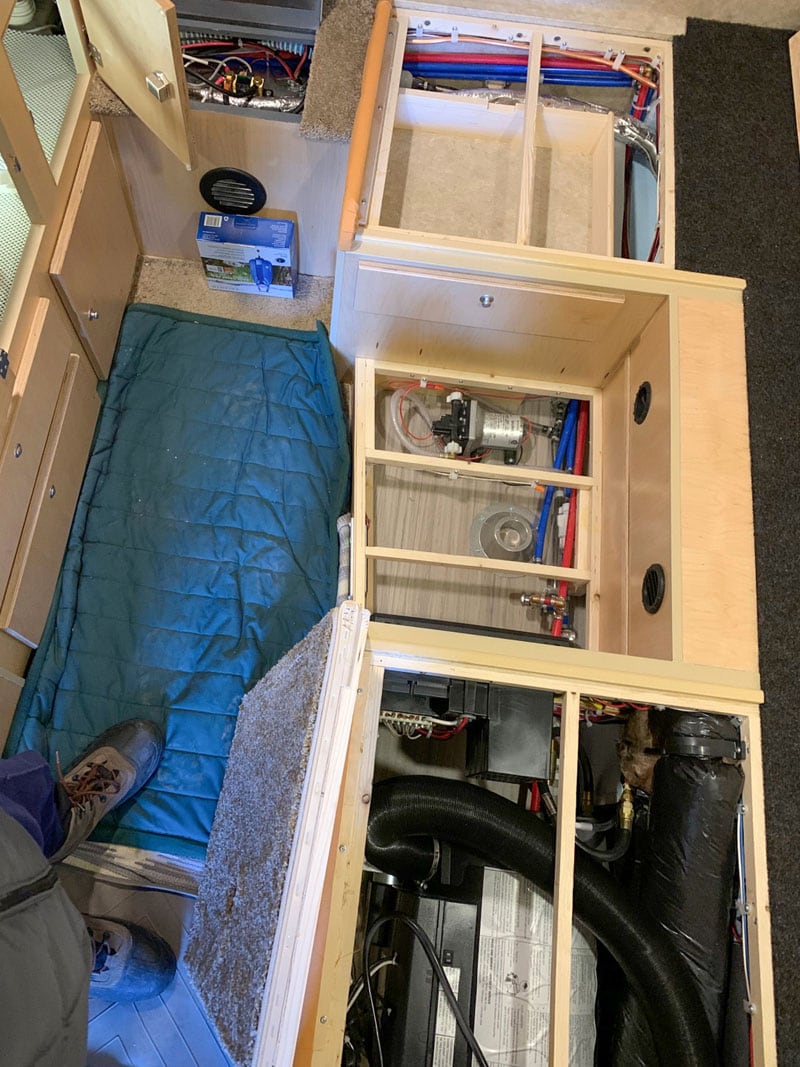
Above: In the lower right is the Truma Combi Eco Plus. The large black hose handles the combustion air from the exterior of the camper. Ducting runs behind the cabinetry next to the water tank (upper right under the shelf), across the lithium battery compartment, and terminates under the sink. This keeps the vital systems warm while warming the interior.
Do you have concerns about using lithium batteries in the cold?
The lithium batteries were put into the Milner’s traditional battery compartment. This is located near the floor, on the front wall, near the front edge of the truck’s bed.
The exterior vent was moved from the battery compartment door and added to the interior wall between the battery compartment and the living quarters. This allows the temperatures to equalize and helps the batteries perform at their best.
Because the Truma system is ducted, one of the ducts passes through the battery compartment which warms the batteries when the heat is flowing. This helps the battery optimally perform. In turn, the battery will last longer and help all the appliances work better.
Other than that, I believe Hallmark used some heavier gauge wiring in some areas of the build and they used a Progressive Dynamic lithium compatible converter to allow effective charging when on shore power. Finally, I installed an isolation switch in the event of an emergency or longer-term storage.
“Because the Truma system is ducted, one of the ducts passes through the battery compartment which warms the batteries when the heat is flowing.”
If you had to design the build over again, would you still opt for lithium batteries?
Lithium batteries are worth the investment and even more so as pricing comes down. They are so much easier to work with, perform exceptionally and require essentially no maintenance. It’s easier to implement lithium in a new build rather than upgrading an older system that may require changing converters, inverters, and chargers.
I have also avoided the costs of installing solar panels, solar controllers, or buying a trickle charger. These components may be needed with AGM or lead acid batteries.
It’s relatively unorthodox to not have at least a portable generator for camping off-grid. It’s outright heretical to not install solar panels for that same application. Tell us how you came to the decision to not have a generator or solar panels.
I left open the possibility for solar. The Hallmark Milner is wired for it. If I do opt for solar, I will probably use portable solar panels at first. Some portable panels come with their own controller making it easier for plug and play. Plus, I could camp in the shade and position the panels in the sun.
Solar also makes sense for any battery system when staying in one place for extended periods. For my style of camping for the night and moving on, I’m able to recharge the system in a few hours of driving, regardless of the weather.
A generator is not needed. For one, it would require a different fuel source from my truck. Creating a place to store and transport the fuel would be a challenge. I’m not a fan of portable gas tanks due to the tank’s expansion and volatility.
We own a Honda generator for the horse trailer so that my wife can run an air conditioner with it due to the Easy Start. But, when we’re dispersed camping, I don’t want the noise, smell, or pollution a generator creates.
If I were to get into a bind, I would run the truck to recharge the lithium batteries. Admittedly, this puts a lot of pressure on the Sterling battery-to-battery charger. If it fails, I might regret not having one more charging solution.
Why did you opt for a compressor refrigerator and not a traditional absorption refrigerator?
We’ve had good success with absorption refrigerators in our travel trailers, but they can be finicky at altitude or in really extreme temperature conditions. There are times when they should be turned off like at gas stations, tunnels, and ferries, and they are supposed to be operated when the camper is within 3º of level. That is not normally a big deal.
Compressor refrigerators don’t have a flame so they can remain on during transit and operate just fine on inclines up to 30º, which is a consideration during overland travel. While not fully tested, I haven’t had any issues operating at higher elevations. Because their primary source is 12-volt, they do draw more amperage. I find this easy to monitor with the Victron BMV 712 whereas propane is harder to monitor in real time.
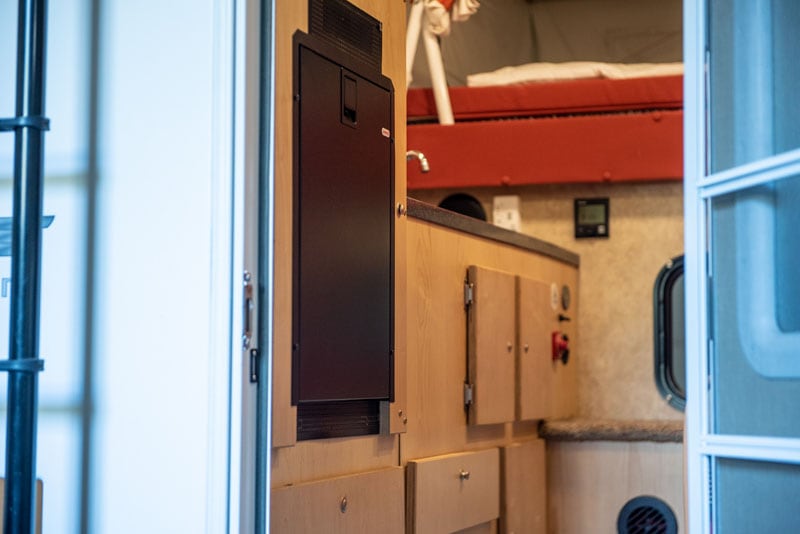
Above: The 12-volt TruckFridge refrigerator. The drawer-style makes it easy to reach in from inside or outside of the camper.
You call your refrigerator a “truck refrigerator”. Was it sourced from the SEMI truck industry?
TruckFridge is a brand name that services the semi-truck industry. It’s a high efficiency, low noise, 12-volt compressor refrigerator. It has a separate refrigerator and freezer, which is impressive with just 1.75 cubic feet of food storage.
The parent company, Indel, owns the Isotherm refrigerator, too. Both refrigerators are made in the same factory with many of the same components and design features. The Isotherm goes through more rigorous certifications and has more styling options, but is functionally very similar.
I chose the TruckFridge for its drawer-style which is easy to access from outside or inside the camper. It was also more affordable than an Isotherm. The technology and quality were comparable with top of the line refrigerators. Plus the overall aesthetic worked well for my application.
Does the refrigerator have a dedicated lithium battery?
No, the refrigerator ties into the camper’s primary 12-volt system. Because it can draw up to five amps an hour and I still wanted to be able to go a few days without charging, I added another Battle Born battery. Now my system has a total of 200 aH.
You performed a cold weather test on your camper, lithium batteries, and Truma system. Do you regularly camp in sub-freezing temperatures?
We tend to camp 10 months out of the year for two to three nights at a time. While we generally don’t plan winter camping trips, given that we like to camp at higher elevations, we can find ourselves dealing with freezing temperatures anytime throughout the year.
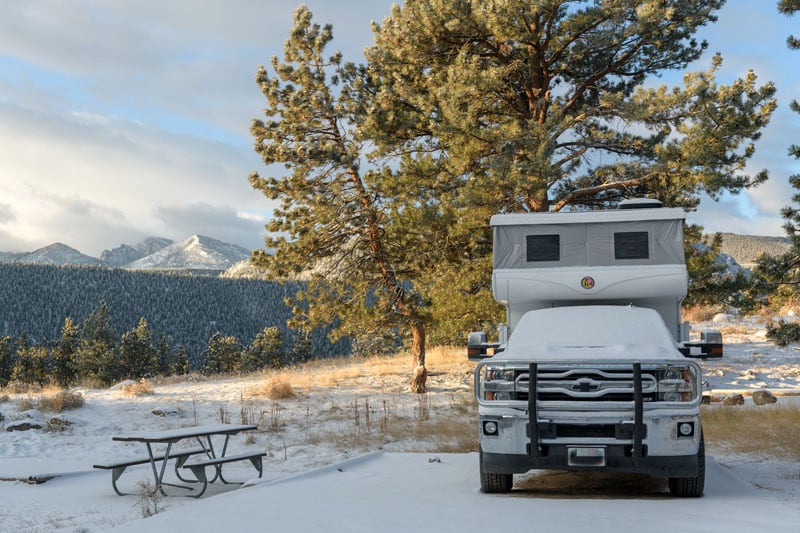
Above: Rocky Mountain National Park, about 8500 feet and 12º F
How long did you camp off-grid in the cold?
The first time the system truly performed as we had hoped was during a trip to Estes Park, Colorado for a family wedding in early November. After the wedding, I retreated into Rocky Mountain National Park and found a nice spot at a campground with no hookups. At 8,500-feet, it was quiet with beautiful views. Then, a cold front moved in.
Winds swirled and temperatures dropped to 12ºF (-11.1ºC). The front brought with it a few inches of light fluffy snow. The Truma cycled on quietly keeping the camper warm and comfortable throughout the night. I had it set at 62ºF (16.6ºC).
The batteries were just a few degrees colder (the Victron BMV 712 has a temperature sensor) as the compartment door transferred some of the cold. I did get a little condensation around the edges of the windows and discovered few areas under the sink where I wanted to direct more heat flow. But, all in all, I was warm and toasty.
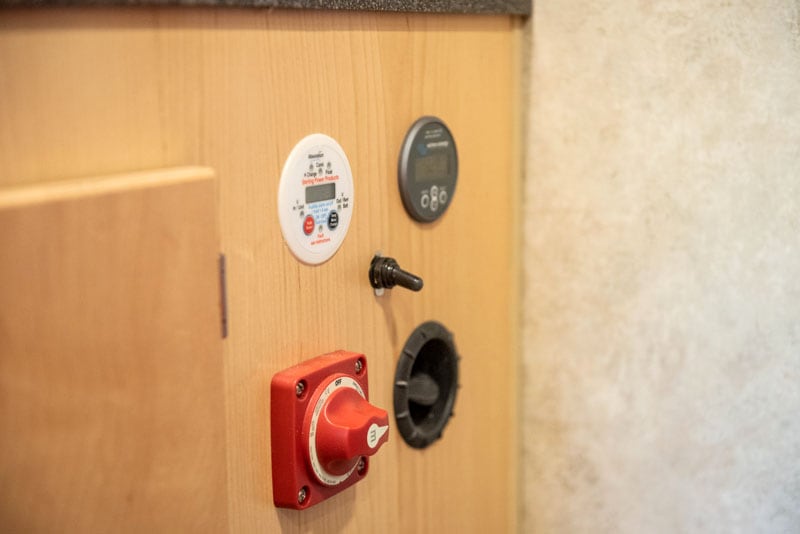
Above: The Command Center a very simple set-up. In the upper right is the Victron BMV 712 which monitors the voltage of the Battle Born batteries and the current draw of the appliances. It can also connect via Bluetooth on the phone. The upper left is the monitor for the Sterling Battery to Battery Charger. The lower left is the red battery isolation switch which is great when storing the camper. The black switch is for the TruckFridge. And the lower right is one of the four heating/ventilation ducts from the Truma.
I processed the wedding photos, drank hot coffee, took in views from the large dinette windows, and was very happy. I used between 20 and 25 amp hours each night for the two nights during these conditions, so I had about 50-percent remaining capacity.
It was bliss. Three nights would have been easy, though four nights I would need to really think about conserving or running the truck long enough to charge up the batteries for insurance.
Battle Born Batteries are designed to perform down to -4ºF (-20ºC) without a significant voltage drop until close to the limit. They will accept a charge at 28ºF (-2.2ºC) and warmer. Of course, if the batteries can remain near the living quarter temperatures 40 to 65ºF (4 to 18.3ºC) they going to perform exceptionally well.
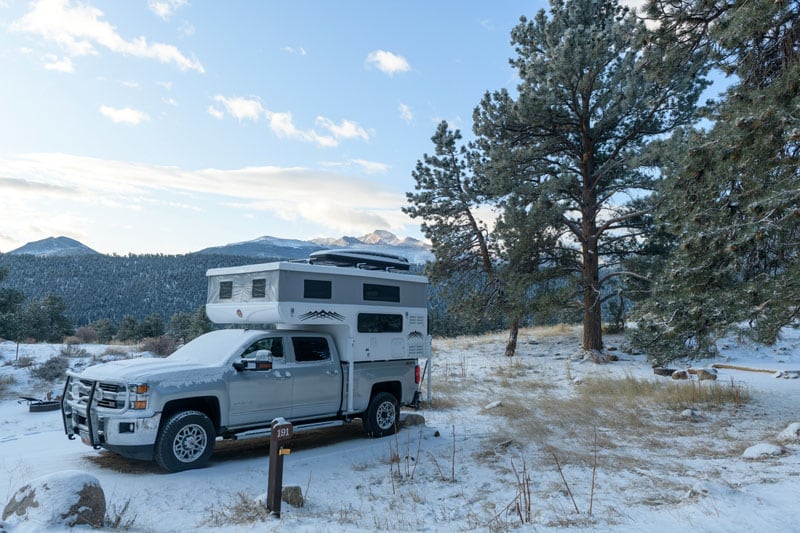
Did you notice any drop in battery performance during the cold weather test?
No, but I was able to keep the batteries warm using the Truma Combi. In winter months, I also keep the camper in a heated garage so the batteries are usually 45ºF+ (7.2ºC+). The situation might be different if I wasn’t prepared and let my camper and batteries stay in temperatures below 0ºF (17.8ºC) and started from there.
If the garage wasn’t an option, I’d likely remove the batteries since they’re pretty light. I do try to keep the batteries in above freezing temperatures though I’m not worried as the internal battery management systems safeguard them.
Is your truck and camper rig complete at this time or are there additional upgrades and modifications you want to make?
Never say never. I’m very happy with how it is set up now. It works fantastic for our needs. Any upgrades would be more focused on the truck’s off-road capability.
The truck is marvelous for towing a gooseneck horse trailer, but for an off-road vehicle its clearance is moderate and it’s on the heavy side as a diesel. Modern diesels with ULSD and DEF, are also limited for some of the international travel we’d like to do.
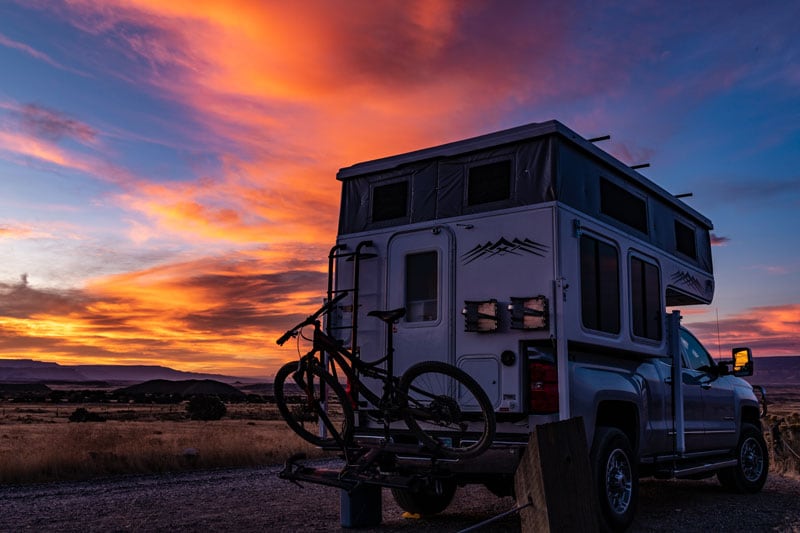
International travel sounds very interesting. We think about that, too. What are your truck camping plans for the future?
In the near term, I look forward to more regional backcountry roads through BLM and National Forest land throughout the western states. In a couple of years, we look forward to doing some international traveling. For this, we’re considering another build with many of these same elements in mind, plus a few more.
The Hallmark Milner is terrific for my current needs and works well for short trips. However, with all the changes brought on by Covid, we’d like to spend more time getting out further and staying out longer.
Once the borders open, we have plans for Alaska, Canada, and Baja. In the longer term, we are also considering some more logistically challenging trips to South America and beyond. It’s more about experiencing new areas without rushing, and less about checking boxes.
Anything else you want to add about your truck camper or lifestyle that we haven’t asked about?
We’re trying our best to not use campfires for cooking and staying warm. We live near and camp in areas prone to wildfires. We’ve stumbled across several situations where campfires were not properly extinguished or people were behaving irresponsibly and wildfires could have easily taken off.
We’re trying to be more self-sufficient and want to keep the land safe. We’re also trying to haul out more than we bring in. This is becoming a mission of ours and hope others will join in practicing a Leaving No Trace and Tread Lightly philosophy.
I get that wood is renewable, propane and diesel are fossil fuels, and lithium has its own set of environmental extraction challenges. However, our hope is that the philosophy of investing in well-designed quality products with workable systems that will last a long time will ultimately help keep people, land, water, and air safer, while allowing us to do a little more good and a little less harm. Only time will tell.
